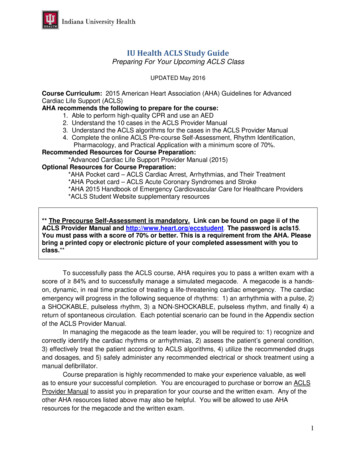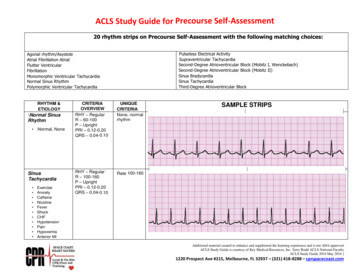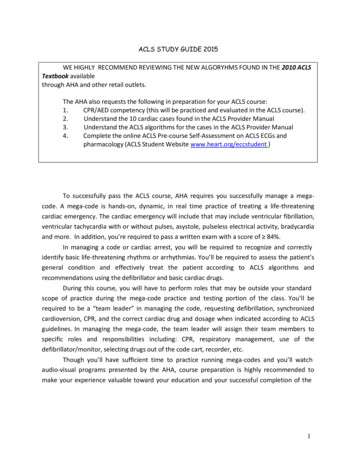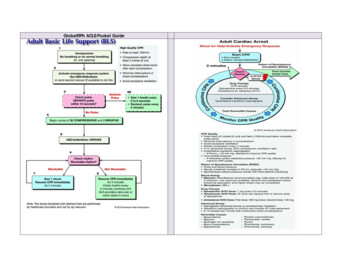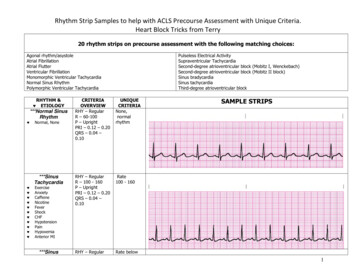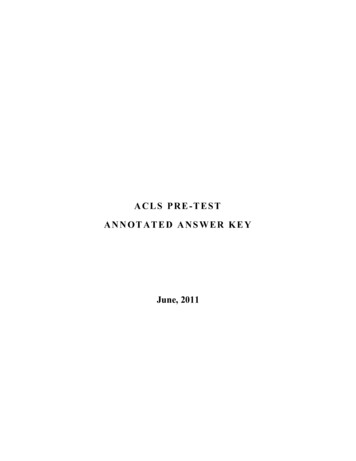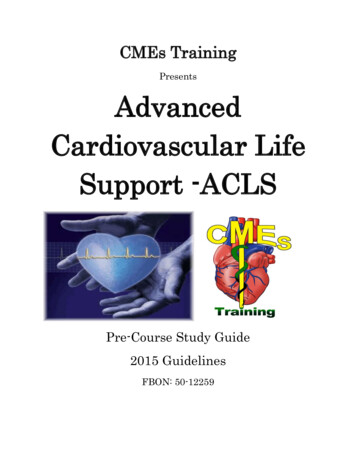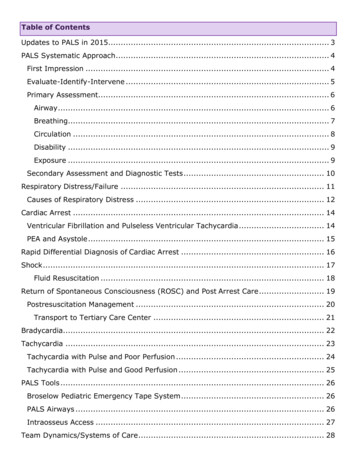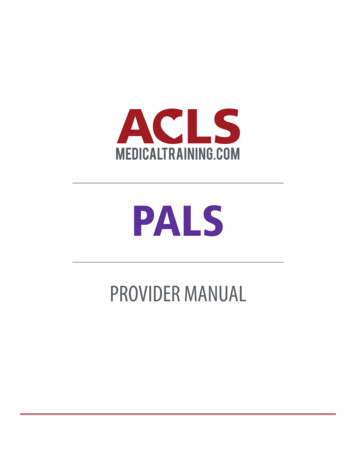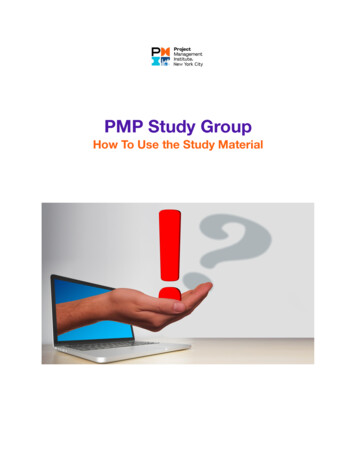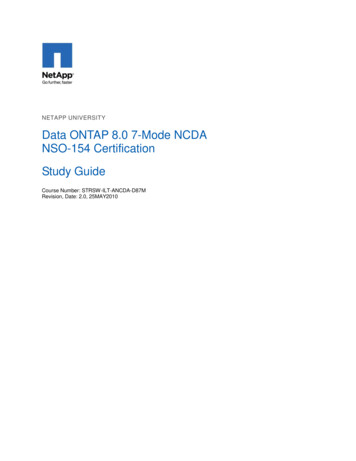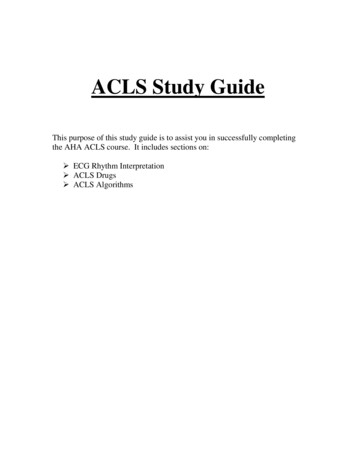
Transcription
ACLSStudy Guidemedtigo.com 413-398-5733 connect@medtigo.com
ACLS Study GuideACLS Study GuideAs a medical graduate, medical student, or practicing physician, getting ACLS-certified isessential. ACLS {advanced cardiac life support} encompasses a set of algorithms that helphealthcare professionals handle medical emergencies. These include cardiovascularemergencies, myocardial infarction, stroke, and cardiac arrests.ACLS training includes guidelines for recognizing and managing these emergencies. It alsoincludes training in handling team communication tactics and team dynamics. Other thanphysicians and medical students, ACLS training is essential for nurses, paramedics, firefighters,and emergency medical technicians.Below are guidelines that will boost your understanding of ACLS.2020 ACLS Guideline ChangesThe current ACLS guidelines have been in use since October 2015. The AHA {American HeartAssociation} is meant to meet in 2020 to review these guidelines to reflect study findings andother changes. Here is a review of the changes to various elements of prior ACLS guidelines.medtigo.com 413-398-5733 connect@medtigo.com
ACLS Study Guide1.CPR and BLS qualityOne of the essentials of optimizing patient outcomes in cardiac arrest remains quality CPR.To guarantee these, the following are the changes that the AHA instituted to CPR and BLSquality: Compression depth: the endorsed depth of chest compressions remains between5cm {two inches} and 6cm {2.4 inches}. Other than the measurements, the qualitychanges in CPR and BLS state that you should avoid excessive chest compressions.Very deep and too many chest compressions have been shown to have adversepatient outcomes. Full chest recoil: AHA also emphasizes that rescuers should avoid leaning on apatient's chest during compressions. This ensures that you achieve full chest wallrecoil. The recoil guarantees the presence of negative wall pressure that returnsblood flow and reinstates myocardial circulation. Minimizing interruptions: the target for the time percentage when performing chestcompressions by the AHA is not less than 60% for CPR. This is called the chestcompression fraction time. Healthcare provider {HCP} BLS: HCPs are required to call for help when they find anunresponsive victim. However, it is practical to continue assessing the victim's pulseand breathing simultaneously during this time. Advanced airway ventilations: healthcare providers should provide one breath everysix seconds at the same time as chest compressions.medtigo.com 413-398-5733 connect@medtigo.com
ACLS Study Guide2.Cardiac arrest medicationsAt times, you might be required to use cardiac medications to manage a patient in ACLS.This is why you should have a background in pharmacology to know the medications to usein an emergency. One of the notable changes to medications in ACLS is the use solely ofepinephrine, rather than vasopressin plus epinephrine, to manage a cardiovascularemergency. This is because there is no evident benefit of administering vasopressin incombination with epinephrine rather than simply using epinephrine alone.3.Post-cardiac arrest managementThere are changes as regards hemodynamic goals, therapeutic hypothermia, and the useof postarrest medication in ACLS. For instance, patients should have a set temperature forsome time after a cardiac arrest to prevent adverse outcomes.4.End-tidal CO2The end-tidal CO2 is a measure of someone's exhaled carbon dioxide. It is among theindicators of a patient's return to spontaneous circulation. The end-tidal CO2 target during acardiac arrest case is above 10mmHg. If you notice the reading is below this, then youshould continue the chest compressions. The end-tidal CO2 reading is also essential whenconfirming the placement of an endotracheal tube. A reading of less than 10mmHg mightindicate that the tube has been popped out.medtigo.com 413-398-5733 connect@medtigo.com
ACLS Study GuideHow to studyYou should first pass an exam for you to be certified and re-certified in ACLS. This is,however, not so easy, even for healthcare workers who have years of experience. Here aresome effective guidelines on how you can study to ace the ACLS exam:Do an algorithm a nightYou should be well-versed in the ACLS algorithms for you to ace your exam. These algorithmsare simple flowcharts on how to handle different elements in a cardiovascular emergency. Tohave the algorithm at your fingertips, start studying early and memorize one per night.Review case scenariosYou will encounter different case scenarios in your career. You should identify the symptomsand signs you deal with and understand the procedures you will employ to manage them. Whenstudying for your ACLS exam, go through as many case scenarios as you can to be adequatelyprepared for the questions.Review advanced airway techniques and indicationsAlthough learning to insert an advanced airway lies beyond the scope of ACLS, it’s stillimportant to review such techniques and the indications of when it may be necessary. This isbecause advanced airways can provide better oxygenation. Several advanced airwaycomponents exist including esophageal tracheal tubes (ET Tube), laryngeal masks, andlaryngeal tubes. Only someone trained in advanced airway techniques should perform theintubation, administering one ventilation every six seconds.Know dosage amountsYou will be needed to identify the medications to use in different ACLS case scenarios. Otherthan knowing the right medications, you should have their right dosages. The incorrect drug ordosage can lead to an adverse outcome in your patient (for example, know the differencebetween endotracheal and intravenous dosing of epinephrine). You can consider usingmnemonic flashcards to remember the medications and dosages easily.Voltages for Defibrillation and CardioversionTwo other important components of the ACLS test is knowing the proper voltages fordefibrillation and cardioversion. These voltages are measured in Joules and need to be precisebased on a patient’s condition and age.Review basic electrocardiographyElectrocardiography is used to assess a patient's heartbeat. The health service provider placeselectrodes on a patient's chest, and the electrocardiogram records the heart's activity on agraph. You should know how to take and interpret an electrocardiography test for you to passyour ACLS exam.Create cue cardsCreating cue cards is another great way to study for the ACLS exam and help you memorize allof the important key components, methods, and algorithms that will appear on the ACLScertification test. Additionally, there are a host of useful web resources to take advantage of, likethis online ECG stimulator.medtigo.com 413-398-5733 connect@medtigo.com
ACLS Study GuideThe Six Algorithms of ACLSAs a part of your training, the following are some of the algorithms that you will cover.Algorithm for suspected strokeAn acute stroke will be categorized as an ischemic or a hemorrhagic stroke. Ruptured bloodvessels will cause a hemorrhagic stroke, while blockage of blood flow to the brain results in anischemic stroke. The ACLS stroke algorithm focuses on a rescuer's rapid evaluation,identification, and intervention. It entails these steps: Recognizing the signs of a stroke.Once you identify a possible stroke, activate the EMS {emergency medicalservice}.Transporting the patient to a hospital with an equipped stroke center ifpossible.Upon hospital arrival, monitor the patient's vital signs, maintaining oxygensaturation at above 94%, and establish IV access. You should also gaugethe patient's neurological status, get a brain CT scan, and consult aneurologist.Use an instrument like the NIH stroke scale to complete a neurological examwith the stroke team or neurologist.Algorithm forsuspected stroke:Chest pain that rediates to the arms, jaw,shoulder; nausea; vomiting; SOBSymptomssuggest MlAspirin, ECG, NTG every5 minutesmorphine if neededGive oxygen if pulse oximetry is 94%CompletefibrinolyticchecklistSTEMI onset ofsymptoms 12hours?YESED door to needle timefor fibrinolytics 30 minutes;Time to PCI 90 minutesNOBegin reperfusion protocol(PCI preferred) or fibrinolyticAdmit to monitored bedAdjunctive therapiesHeparin, beta blockersACE inhibitorsmedtigo.com 413-398-5733 connect@medtigo.comFigure 1:ACLS ACUTECORONARYSYNDROMEALGORITHM
ACLS Study GuideAcute coronary syndrome {ACS} algorithmThis encompasses several cardiac issues, including STEMI {ST-segment elevation myocardialinfarction} and unstable angina. The ACS algorithm aims to relieve chest pain, identify the typeof cardiac event, and prevent major adverse effects.Tachycardia is a heartbeat that is above 100 bpm in adults. Bradycardia is a heartbeat of lessthan 60 bpm in adults (although symptoms usually develop when heart rate drops below 50bpm). The algorithm for bradycardia and tachycardia includes: The identification and treatment of the cause of tachycardia or bradycardia.Monitoring cardiac rhythm, oxygenation, and blood pressure.Determining the patient's stability.Inserting IV for medication.For tachycardia, administering an IV adenosine 6mg bolus. If this does not work, startingan IV procainamide 20-50mg infusion.For bradycardia, administering atropine 0.5mg. If this does not work, consider adopamine or epinephrine infusion.Tachycardia Algorithm:Attempt to identify causebut do not delay treatmentEmergency treatment:Vagal ManeuversSynchronized CardioversionMedicationsMaintain oxygensaturation 94%Unstable - hypotension,decreased LOC,shock,chest painStable?NOSynchronized cardioversionCardioversion Rules:QRS narrow and regular;cardiovert at 50-100 joulesQRS narrow and regular;cardiovert at 120-200 joulesYESEstablish IV or IOConsider adenosine 6mg bolus:may give second dose at12mgIf adenosine not effective;consider procalnamideOR amiodaroneQRS wide and regular;cardiovert at 100 joulesQRS wide and irregular, turn offthe synchronized mode anddefibrillate immediatelyConsider anantiarrhythmic infusionmedtigo.com 413-398-5733 connect@medtigo.comFigure 2:ACLSBRADYCARDIAALGORITHM
ACLS Study GuideBradycardia Algorithm:Bradycardia identifiedPossible Causes:HypoxiaAcidosisHyperkalemiaHypothermiaHeart blockToxinsTraumaLook for causebut do not delaytreatmentEstablish airway:assist breathingif necessaryMonitor heart rateand rhythm andblood pressureMonitor pulse oximetry orwaveform capnographyif availableEstablish an IV or IO accessAtropine 0.5mgRepeat every 3-5minutes to 3mgContinue to monitor:Call for ConsultsNOHypotensionor Shock?YESIf atropine not effective, considertranscutaneous pacing ORdopamine infusion ORepinephrine infusionFigure 3:ACLSTACHYCARDIAALGORITHMmedtigo.com 413-398-5733 connect@medtigo.com
ACLS Study GuideBLS AED algorithmThis encompasses the steps of a basic life support {BLS} survey and the use of an AED{automated defibrillator device}. For the BLS survey, secure the scene and assess the state ofthe victim. The following is the algorithm for using AED for managing a cardiac arrest: Continue with CPR until you attach the AED pads and power the device.Stop CPR when the device is ready and expose the victim's dry skin and chest ifnecessary.Open the pads and stick them on the patient’s chest.Follow the voice instructions provided by the AED.The AED will assess the rhythm and instruct you to defibrillate if a shockable rhythm ispresent.If there is no shockable rhythm detected, continue CPR for two minutes, then repeat theAED analysis until the EMS arrives or the victim is conscious.BLS AED Algorithm:Get the AED and turn it ob;Listen to and follow theverbal instructionsFeel for hard lumps in theupper chest; do not place thepads over these lumpsPeel the backing off thepads and apply to thevictim’s chestPlace one pad on the upperright chest;Place the 2nd pad under the leftarmpit by the left nippleEnsure that the pads areattached to the AED boxClear everyone away from the victim;Allow AED to analyze rhythmYESCall out “Clear” andpress shock buttonShockAdvised?NOContinue CPR for 2 minutesmedtigo.com 413-398-5733 connect@medtigo.comFigure 4:BLS AEDALGORITHM
ACLS Study GuideACLS cardiac arrest PEA and asystole algorithmIf BLS and AED interventions are unsuccessful, rescuers will implement the appropriatealgorithm for non-shockable cardiac arrest. This is called an asystole or PEA {pulselesselectrical activity} cardiac arrest. Here are the algorithms for these events: Continue CPR, then administer IV epinephrine 1mg, and again after 3-5 minutes ifnecessary.Stop CPR every two minutes to assess the cardiac rhythm and defibrillate if you getshockable rhythms.When identified, manage the cause of the asystole or PEA.If the patient returns to spontaneous consciousness, start on the post-cardiac arrestalgorithm.Continue CPR;Airway; Oxygen;Connect monitorsCardiac ArrestPEA and AsystoleAlgorithm:Go to Cardiac Arrest:VTach or VFib algorithmEpinephrine1mg ASAP and every 3-5 minutesYESEvaluate rhythm:VTach or VFib?NOReview listingof H’s and T’sEvaluate and treatreversible causesNOReturtn ofSpontaneousCirculation?YESGo to Post Cardiac Arrest Casemedtigo.com 413-398-5733 connect@medtigo.comFigure 5:ACLS CARDIACARREST PEAAND ASYSTOLEALGORITHM
ACLS Study GuideACLS cardiac arrest VTACH and VFIB algorithmVFIB {ventricular fibrillation} and VTACH {ventricular tachycardia} are both pulseless rhythms incardiac arrest. Here are the algorithms for their management: DefibrillateContinue with CPR for two minutes.Give IV epinephrine 1mg every 3-5 minutes until the return of spontaneous circulation.Continue CPR;Airway; Oxygen;Connect monitorsCardiac ArrestVTACH and VFIBAlgorithm:Identify rhythm andgo to appropriatealgorithmNOEvaluate rhythm:VTach or VFib?YES120-200 joules on abiphasic defibrillatoror 360 joules on amonophasic defibrillatorDefvibrillateContinue CPR for 2 minutesEpinephrine1mg every 3-5 minutesAmiodarone OR lidocaineNOGo to Post Cardiac Arrest CaseYESReturt
Study Guide. As a medical graduate, medical student, or practicing physician, getting ACLS-certified is essential. ACLS {advanced cardiac life support} encompasses a set of algorithms that help healthcare professionals handle medical emergencies. These include cardiovascular emergencies, myocardial infarction, stroke, and cardiac arrests. ACLS training includes guidelines for recognizing and .
